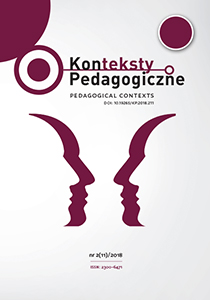Abstract
In the article, I analyse the fascinating (from the perspective of culture-related mainstream media research) phenomenon of building meanings through a specific composition of images – photographs, their placement in the macro-structure of the website, the number of additions (comments, tags, loca-tions) forming the so-called chain of meanings and being one of the pillars of the modern media education. The specifics of the discussed phenomenon are primar-ily influenced by the observation point: the level of image comprehension largely depends not only on the observer’s perception (understood even in an extremely general way), but also on the level of media competencies (acquired through con-scious or unconscious education), the need to interpret the surrounding space filled with images – or more precisely understood as the place for “hanging” vari-ous images (static, but moving) and a specific social (situation) position.
References
Baudrillard, J. (2010). Świat wideo i podmiot fraktalny, trans. A. Gwóźdź. In: A. Gwóźdź (ed.), Po kinie. Film w kulturze uczestnictwa (p. 247–258). Warszawa: Oficyna Na-ukowa.
Bielak, T. (2014). Antyklerykalizm x.0 – komunikacje w mediach społecznościowych na przykładzie “ASZDziennika” i Antykleryka. Świat i Słowo, 2(23), 313–325.
Bielak, T. (2012). Walczące obrazy. Medialne strategie i społeczeństwo lęku. Kultura Współczesna, 4, 132–141.
Dziewit, J. (2014). Aparaty i obrazy. W stronę kulturowej historii fotografii, Katowice: grupakulturalna.pl.
Feuer, J. (2011). HBO i pojęcie telewizji jakościowej. In: T. Bielak, M. Filiciak & G. Ptaszek (eds.), Zmierzch telewizji. Przemiany medium. Warszawa: Scholar.
Gitelman, L. (2006). Always Already New. Media, History and the Data of Culture. London: Cambridge MA.
Halawa, M. (2013). Platforma algorytmicznej towarzyskości i technologia siebie.Kultura i Społeczeństwo (Konsumpcja i kulturapopularna), 4, 117–144.
Jurgenson, N. (2011). The Faux-Vintage Photo. Full Essay (Parts I, II, and III), www.thesocietypages.com [accessed: 30.11.2018].
Levinson, P. (2010). Nowe nowe media, trans. M. Zawadzka. Kraków: WAM.
Lubiak, J. (ed.). (2006). Obrazy jak malowane. Bielsko-Biała: Galeria Bielska BWA.
Michałowska, M. (2012). Foto-teksty. Związki fotografii z narracją. Poznań: Wydawnic-two Naukowe Uniwersytetu im. Adama Mickiewicza.
Mitchell, W.J.T. (2015). Czego chcą obrazy?, trans. Ł. Zaremba. Warszawa: Narodowe Centrum Kultury.
Piekot, T. (2006). Werbalizacja i wizualizacja w dyskursie wiadomości prasowych. In: E. Tabakowska (ed.), Ikoniczność znaku. Słowo – przedmiot – obraz – gest (p. 99–116). Kraków: Universitas.
Potocka, A.M. (2010). Fotografia. Ewolucja medium sztuki. Warszawa: Aletheia.
Składanek, M. (2011). Tworzywo bez właściwości – technologia cyfrowa jako metame-dium. Przegląd Kulturoznawczy, 1(9), 37–45.
Svalander, A. & Wiberg, M. (2015). The Practice of Selfies, Interactions, 22(4), 34–38.
Zaremba, Ł. (2015). Obraz jako przedmiot sporu w kulturze polskiej po 1989 roku w ujęciu studiów nad kulturą wizualną. Warszawa [a typed copy of the dissertation disclosed by the author].
Zawojski, P. (2006). Daniel Lee, czyli hybrydyczności fotografii cyfrowej. Teoria i prak-tyka. Rocznik Historii Sztuki PAN, www.zawojski.com [accessed: 30.11.2015].
In accordance with the recommendation of the Ministry of Science and Higher Education, which aims to counteract the practice of “ghostwriting” and “guest authorship,” all authors submitting their text for publication should attach an author’s statement which declares the contribution of each of the authors to the article. The printed and signed statement should be delivered by mail or other means to editor-in-chief Joanna Skibska or sent in the form of a scan to the following e-mail address: redakcja@kontekstypedagogczne.pl. The authors will not receive remuneration for publishing their papers. The editors reserve the right to make minor editorial changes to the articles which will not affect the substance of the article. We encourage all authors to prepare their articles in accordance with the guidelines for manuscript preparation. Download pdf file.
Authors transfer all copyrights and grant the journal the right of first publication with the work simultaneously licensed under a Creative Commons Attribution License that allows others to share the work with acknowledgement of the work's authorship and initial publication in this journal. All authors agree to the publishing of their email addresses, affiliations and short bio statements with their articles during the submission process.

